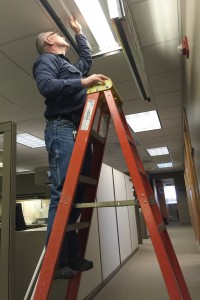The holidays are right around the corner. Do you have your decorations up? If not, you might be tempted to do it soon.
Dr. Eric Watson, a lower extremity specialist with Orthopedic Institute in Sioux Falls, recommends everyone take extreme caution when using a ladder this holiday season.
According to the World Health Organization, the United States leads the world in ladder deaths. Each year, there are more than 164,000 emergency room-treated injuries and 300 deaths in the U.S. that are caused by falls from ladders
"I have worked with patients who fell from ladders on multiple occasions," said Watson. "It generally takes six weeks for a foot or ankle injury to heal, but that is after the surgery. Most cases are surgical but we have to wait to complete the surgery until the swelling has gone down. A foot or ankle injury could really ruin your holiday season."
Watson said the most common injuries he sees are broken ankles and feet, but it all depends on how a person falls.
"If you jump off and land on your feet you're probably going to do some damage to your feet or ankles, but if you land on your hands, you can harm your wrists, hands or arms," he said. "You could also fall on your back and hurt your head or neck."
Oftentimes, falls cause injuries in several areas, Watson said.
"There is almost always an associated injury to go with the broken bones," he said. "A common one is a compound compression fracture in your back, which is very painful."
Watson offered these tips to avoid injuries while working on ladders:
- Always inspect the ladder to make sure it is in good working condition.
"Make sure there is no excess mud on the rungs that could cause you to slip and make sure all the ladder components are working properly," he said.
- Always place ladders on a level surface.
"Make sure the hinges are locked out and the legs are as level as possible," Watson said.
- Always face the ladder when climbing and wear clothing that allows you to keep a good grip on the rungs.
- Place the ladder as close to where you'll be working as possible.
"You don't want to have to reach off the ladder very far," Watson said. "The further from the center of gravity you are, the more likely you'll tip the ladder."
- If possible, have someone hold the ladder.
"This is especially important if you don't have a good, level surface," he said.
- Never step on the top rung or the paint bucket shelf.
"Do exactly as the label says and stay off," he said. "(Ladder manufacturers) really mean it; the warning labels are there for a reason."
- Use a job-appropriate ladder.
"You don't need to use a 14-foot ladder to reach up three feet," he said. "The higher up you are, the more worried you should get because the ladder will be less stable. Make sure your ladder is the appropriate height for the job."
Some common sense and a bit of planning will go a long way in preventing ladder injuries, Watson said.
"The old adage, 'An ounce of prevention is worth a pound of cure,' is certainly true here," he said.



